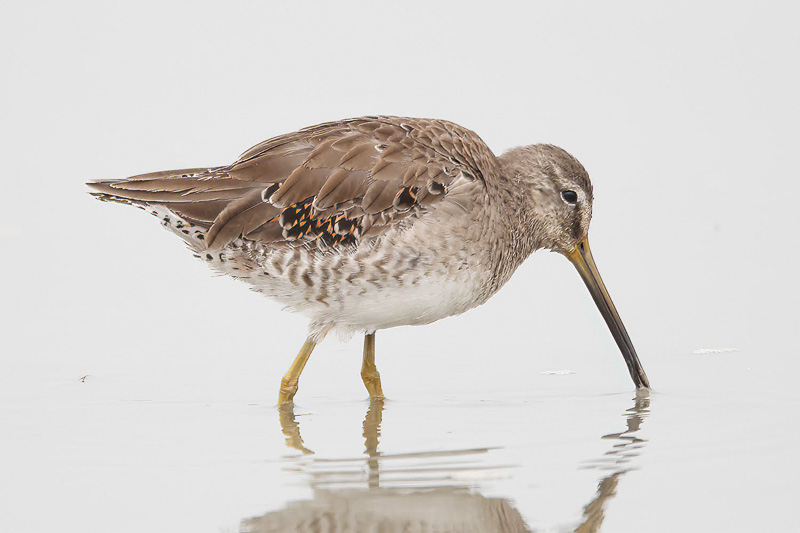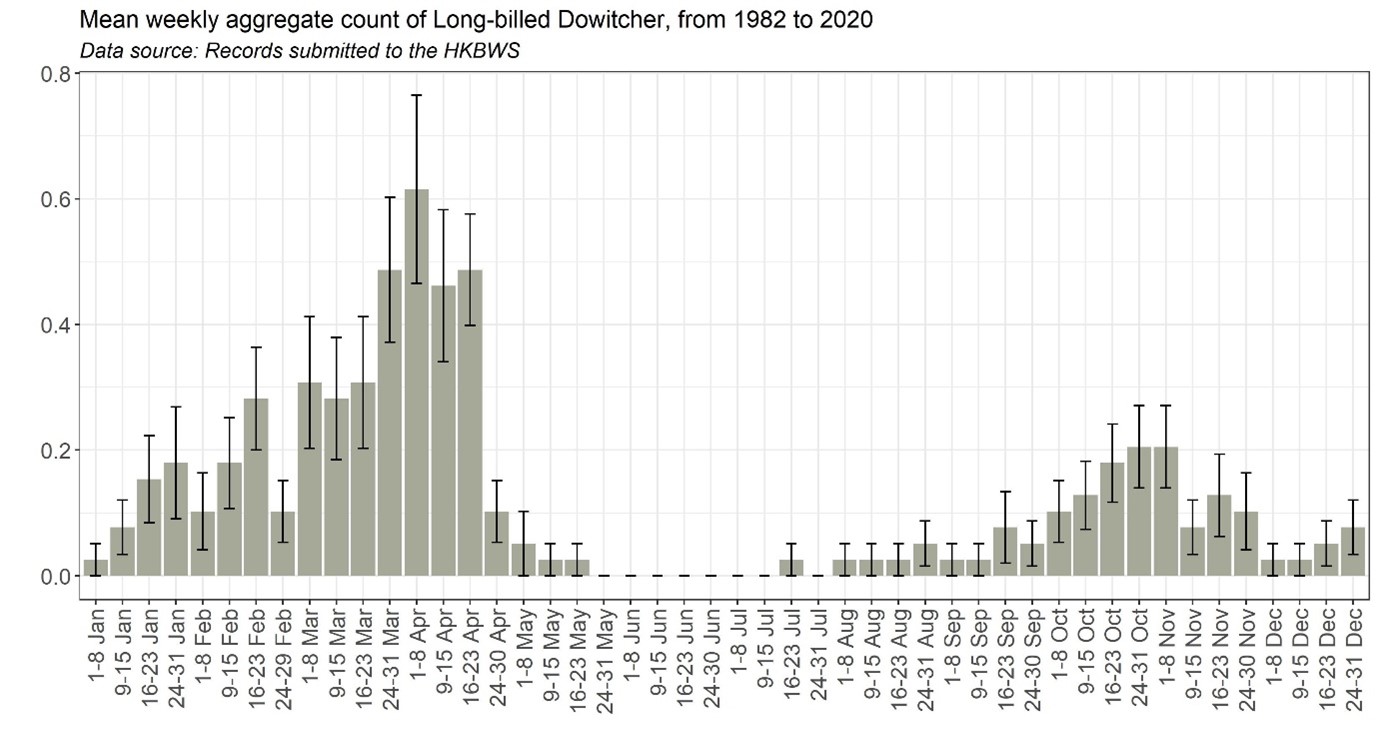Long-billed Dowitcher Limnodromus scolopaceus 長嘴鷸
Category I. Scarce passage migrant and winter visitor to Deep Bay area.
IDENTIFICATION

Jan. 2012, Michelle and Peter Wong. Non-breeding plumage.
29 cm. Similar to Common Snipe in size, and thus noticeably smaller than Asian Dowitcher, with greenish legs, pale bill and a well-marked whitish supercilium. In flight shows narrow white elongated diamond up back, barred underwing coverts and white trailing edge to secondaries and inner primaries. In non-breeding plumage has grey-brown scapulars and coverts that are dark along the shaft, greyish chest and white belly.

Apr. 2011, Martin Hale. Moulting into breeding plumage.
On this bird blackish breeding plumage upperpart feathers that are irregularly barred orange-brown are appearing. In full breeding plumage has rusty underparts (different from more cinnamon tone of Asian Dowitcher) with extensive blackish barring and spotting on upper chest, flanks and undertail coverts.
Juvenile has wholly dark centres to tertials, greater coverts and scapulars with clear-cut buff fringes
VOCALISATIONS
The typical flight call, which is important in distinguishing this species from the extra-limital Short-billed Dowitcher L. griseus, is a diagnostic short and sharp ‘kyip’ that is uttered in irregular series when alarmed or flushed.
DISTRIBUTION & HABITAT PREFERENCE
All records have occurred in the Deep Bay area on intertidal mudflats or adjacent roost areas, mainly on Mai Po NR.
OCCURRENCE
Carey et al. (2001) reported four records of Long-billed Dowitcher and at least eight records of Dowitcher sp., either Long-billed or Short-billed. In the interim, however, it has become clear that the default species in HK is Long-billed, and in this account all these records are regarded as such.
First recorded on 19 April 1982 (Chalmers 1984), Long-billed Dowitcher has subsequently proved to be a passage migrant in both spring and autumn, with a smaller wintering population. Figure 1 indicates that it is more numerous on spring passage, although the difference may be slightly exaggerated due to its being easier to identify in breeding plumage.
The earliest autumn record is of one on 22 July 2015, and there are rather few records until the first week of October when passage increases. The peak period is the last week of October and first week of November. Numbers subsequently appear to decline, and records increase from mid-January; however, this may be an artefact of the lack of high diurnal tides in December and early January.
Spring passage appears to occur from the first week of March or possibly later, peaking from the last week of the month to the third week of April. The latest spring record occurred on 16 May 2016. The highest count is of four during 6-7 April 2011.
BEHAVIOUR, FORAGING & DIET
Its distinctive ‘sewing machine’ foraging action indicates it is a tactile feeder largely consuming animal prey in soft muddy substrates.
RANGE & SYSTEMATICS
Monotypic. Breeds in coastal areas of west and north Alaska and adjacent northwest Canada; also scattered breeding populations in north and northeast Siberia from the Chukotka peninsula west to the Yana River (Takekawa and Warnock 2020). In China records are scattered across lowland areas of the country from Xinjiang in the west to the eastern seaboard (Liu and Chen 2020). Based on Hong Kong records small numbers spend the winter in coastal areas of south China.
CONSERVATION STATUS
IUCN: NEAR-THREATENED. Population trend decreasing at a rate of 20% over three generations for reasons that are unclear.
Figure 1.

Chalmers, M. L. (1984). Systematic List for 1982. The Hong Kong Bird Report 1981/82: 52-86.
Liu, Y. and Y. H. Chen (eds) (2020). The CNG Field Guide to the Birds of China (in Chinese). Hunan Science and Technology Publication House, Changsha.
Takekawa, J. Y. and N. D. Warnock (2020). Long-billed Dowitcher (Limnodromus scolopaceus), version 1.0. In Birds of the World (A. F. Poole and F. B. Gill, Editors). Cornell Lab of Ornithology, Ithaca, NY, USA. https://doi.org/10.2173/bow.lobdow.01

